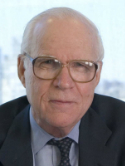Regulation and heteromeric structure of the fibroblast activation protein in normal and transformed cells of mesenchymal and neuroectodermal origin Journal Article
| Authors: | Rettig, W. J.; Garin-Chesa, P.; Healey, J. H.; Su, S. L.; Ozer, H. L.; Schwab, M.; Albino, A. P.; Old, L. J. |
| Article Title: | Regulation and heteromeric structure of the fibroblast activation protein in normal and transformed cells of mesenchymal and neuroectodermal origin |
| Abstract: | The human fibroblast activation protein (FAP), defined by monoclonal antibody F19, is expressed in vivo in reactive stromal fibroblasts of epithelial cancers, subsets of bone and soft tissue sarcomas, and granulation tissue of healing wounds. FAP is generally absent from the stroma of benign epithelial tumors and normal adult tissues. In vitro FAP induction is observed in proliferating cultured fibroblasts and in melanocytes grown with fibroblast growth factor and phorbol ester. In the present study, we show that fibroblast and melanocyte FAP is a cell surface protein comprising noncovalently linked Mr 95,000 (p95) and Mr 105,000 (pl05) sub-units. In contrast, cultured sarcoma and melanoma cell lines express only p95 or are FAP negative. Immunoblot experiments show that p95, but not pl05, carries the epitope defined by monoclonal antibody F19. Furthermore, peptide maps of purified p95 and pl05 differ, suggesting that they may be distinct gene products. Loss of FAP or a change from p95/pl05 to p95 expression accompanies the acquisition of growth factor independence and tumorigenicity in several in vitro test systems, including simian virus 40 transformation of normal fibroblasts, Ha-ras transformation of normal melanocytes, supertransformation of osteosarcoma cells, and enhanced N-AfFC expression in variant neuroblastoma cells, whereas serum-starved normal fibroblasts continue to express p95/pl05. Thus, FAP expression appears to be linked to the growth factor-dependent proliferative capacity of normal cells and is not merely a secondary event in proliferating cells; furthermore, FAP expression is inversely correlated with growth factor independence and tumorigenicity in transformed cell lines. This distribution pattern is consistent with a role for p95/pl05 in mediating extrinsic, growth regulatory signals in normal cells, possibly as a heteromeric cell surface receptor. Such a physiological function may be obviated when oncogenes with cytoplasmic or nuclear sites of action are activated, reducing extrinsic growth factor dependence and permitting down-regulation of FAP in certain transformed cells. © 1993, American Association for Cancer Research. All rights reserved. |
| Keywords: | nonhuman; cells, cultured; mesenchyme cell; gene expression; melanocytes; breast; breast neoplasms; sarcoma; oncogene; neuroblastoma; cell transformation; simian virus 40; fibroblasts; down regulation; oncogene c myb; molecular weight; epithelium tumor; oncogene ras; cell transformation, viral; cell surface receptor; granulation tissue; growth substances; carcinogenic activity; human; female; priority journal; article; support, non-u.s. gov't; support, u.s. gov't, p.h.s.; differentiation inducing factor |
| Journal Title: | Cancer Research |
| Volume: | 53 |
| Issue: | 14 |
| ISSN: | 0008-5472 |
| Publisher: | American Association for Cancer Research |
| Date Published: | 1993-07-15 |
| Start Page: | 3327 |
| End Page: | 3335 |
| Language: | English |
| PUBMED: | 8391923 |
| PROVIDER: | scopus |
| DOI/URL: | |
| Notes: | Source: Scopus |
Citation Impact
Related MSK Work








